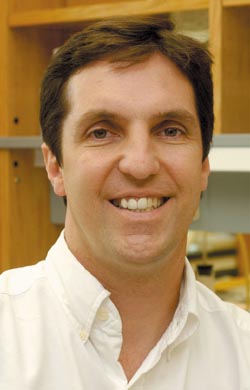
S. K. Dey, Ph.D.
Reproductive and Developmental Biology research team brings varied backgrounds, expertise

B. C. Paria, Ph.D.

Sanjoy Das, Ph.D.

Dr. Jeff Reese
S. K. Dey, Ph.D.
For the past three decades, S. K. Dey has focused his efforts on understanding how the embryo makes first contact for attachment to the uterine wall, and a raft of projects is in the works.
One effort looks at how COX-2 derived prostaglandins are involved. These inflammatory molecules flare up when the body has a problem, like arthritis or headache. In COX-2 knockout mice, where the gene encoding the rate-limiting step in prostaglandin synthesis has been removed, ovulation of eggs is scant and fertilization of the eggs that are produced is poor. The few eggs that are fertilized can’t implant in the uterine wall. A normal embryo transplanted into the knockout mouse also fails to implant, suggesting that this process is specifically affected.
Dey is also looking at the role of growth factors and cytokines, especially the EGF (epidermal growth factor) family of growth factors, in embryo implantation and development. In addition, his interest has turned in the past 10 years or so to the role of cannabinoids in pregnancy.
Cannabinoids are chemicals found naturally in our bodies, and also, perhaps more familiarly, in marijuana. These molecules act as neurotransmitters in the brain, but they came to Dey’s attention by way of a study showing a possible estrogenic effect in a study of Vietnam veterans who were chronic marijuana smokers and who developed breasts (gynecomastia). Though that association was never confirmed, Dey did find that the mouse pre-implantation embryo (blastocyst) has 25-fold more cannabinoid receptors than the brain, and that the cannabinoid-like ligand (called anandamide, from the Sanskrit word meaning “bliss”) that activates the receptor is produced in the uterus. His lab has produced evidence that this receptor-ligand signaling must be optimally balanced for successful synchronizing of pre-implantation development of the embryo and preparation of the uterine lining.
B. C. Paria, Ph.D.
Bibhash Paria’s lab has developed a hamster model to investigate the interplay of estrogen and progesterone in the uterus during implantation. Mice and rats need both hormones for implantation, but the dogma in hamster has been that ovarian estrogen is not required — only progesterone is needed. Based on evidence seen in other mammals, Paria believes that the same might be true of humans, so the hamster is a good model for testing that theory.
The mouse is Paria’s model of choice in a second major project in his lab, studying how the embryo is protected from the time of implantation to the time when the placenta takes over. His goal, he says, is to find out whether the uterine tissue surrounding the embryo changes its nature in some way to create a barrier shielding the new and foreign inhabitant from the mother’s immune system and other molecules of maternal origin.
Sanjoy Das, Ph.D.
Modification of the uterine wall at the site of implantation is also the focus of one of Sanjoy Das’s research projects. After the embryo attaches to the uterus, the stromal cells at that site are transformed into specialized cells called decidual cells, which help support the developing embryo until the placenta is formed. In the transformation process, which is called decidualization, the normal cell cycle is disrupted, producing cells that have abnormally large amounts of DNA. Working with the mouse model, Das hopes to identify the key regulatory molecules involved in decidualization, and the molecules that signal these cells to undergo apoptosis — that is, die — within three days of their transformation.
In a separate project, Das is using the mouse model to better define estrogen activity in the uterus during implantation. Estrogen normally exerts its regulatory action through two well-known, classical receptors. Blocking these receptors in the uterus, however, doesn’t stop estrogen’s action. Das is on a mission to discover the alternate means that estrogen uses to influence uterine function and gene expression, and he has identified a number of estrogen-induced signaling molecules — Wnt, Frizzled, and BiP, to name a few — that may help him home in on his target.
Dr. Jeff Reese
Jeff Reese is a neonatologist, a physician trained to care for pre-term babies and other sick newborns, who has blended his neonatal practice with a scientific interest in embryo development. Specifically, he is interested in events surrounding labor and birth. What triggers a woman to go into labor? What gets her uterus ready when the week before it wasn’t ready? And what about the fetus — how does it participate in initiating labor? Answers to these questions could help physicians prevent premature birth, as well as problems associated with delayed birth, when a mother fails to go into labor.
According to Reese, a lot of what happens in early establishment of pregnancy is also relevant at the end of pregnancy. It turns out that another member of the COX family of enzymes, COX-1, has a role. The COX-1 knockout mouse has no problem with fertilization, or with implantation of the embryo. It has a different problem: it doesn’t go into labor. Pups delivered by Caesarian-section and raised by a foster mother suckle and grow, so it appears the problem lies not with them but with the mother being able to deliver.
Reese has tried giving the mice oxytocin (the potent uterine contractile agent known as pitocin commonly used to induce labor in women) to no avail, which suggests that COX-1 derived prostaglandins are necessary for labor. Ripening of the cervix, the entrance to the birth canal, is another prostaglandin-dependent event. And the hormones that control pregnancy — estrogen and progesterone — probably act on the prostaglandin pathway, Reese says. He believes that, rather than having a network of parallel events happening at the same time, there might be a staged series of prostaglandin-induced effects, all stemming from COX-1 and COX-2 triggers. His lab is dedicated to understanding the choreography of prostaglandin signaling that affects labor and delivery.













